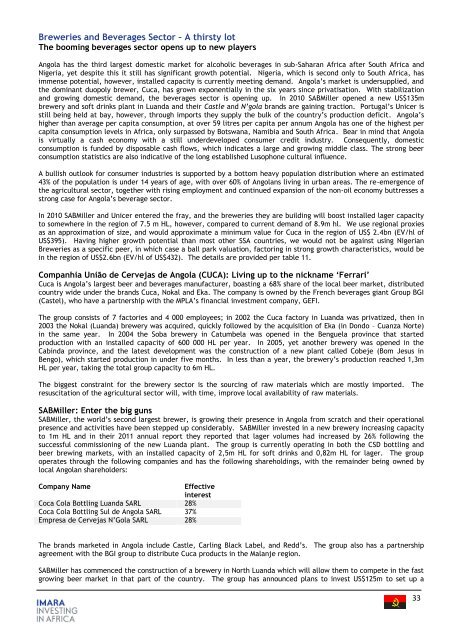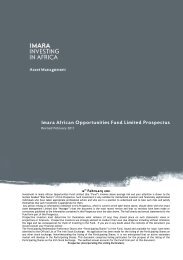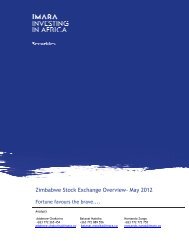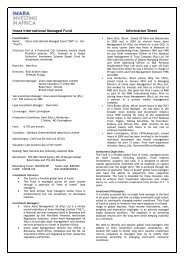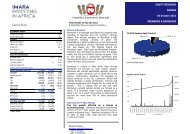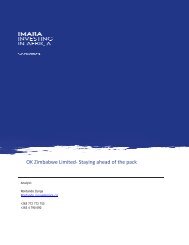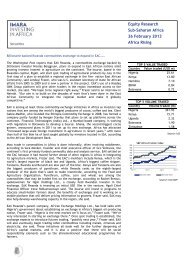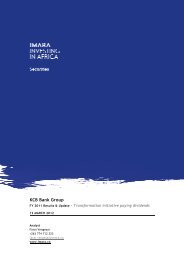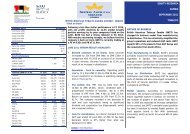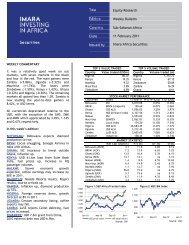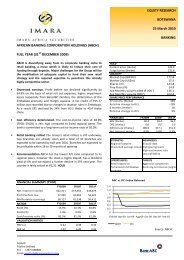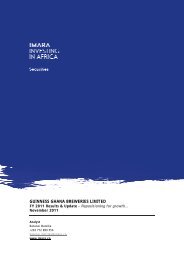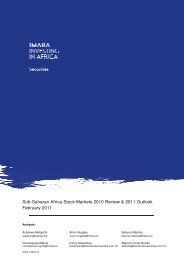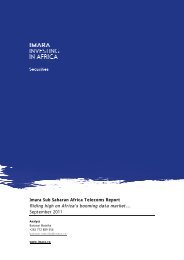Imara African Cement Report Africa, the last cement frontier Angola ...
Imara African Cement Report Africa, the last cement frontier Angola ...
Imara African Cement Report Africa, the last cement frontier Angola ...
You also want an ePaper? Increase the reach of your titles
YUMPU automatically turns print PDFs into web optimized ePapers that Google loves.
Breweries and Beverages Sector – A thirsty lot<br />
The booming beverages sector opens up to new players<br />
<strong>Angola</strong> has <strong>the</strong> third largest domestic market for alcoholic beverages in sub-Saharan <strong>Africa</strong> after South <strong>Africa</strong> and<br />
Nigeria, yet despite this it still has significant growth potential. Nigeria, which is second only to South <strong>Africa</strong>, has<br />
immense potential, however, installed capacity is currently meeting demand. <strong>Angola</strong>‟s market is undersupplied, and<br />
<strong>the</strong> dominant duopoly brewer, Cuca, has grown exponentially in <strong>the</strong> six years since privatisation. With stabilization<br />
and growing domestic demand, <strong>the</strong> beverages sector is opening up. In 2010 SABMiller opened a new US$135m<br />
brewery and soft drinks plant in Luanda and <strong>the</strong>ir Castle and N’gola brands are gaining traction. Portugal‟s Unicer is<br />
still being held at bay, however, through imports <strong>the</strong>y supply <strong>the</strong> bulk of <strong>the</strong> country‟s production deficit. <strong>Angola</strong>‟s<br />
higher than average per capita consumption, at over 59 litres per capita per annum <strong>Angola</strong> has one of <strong>the</strong> highest per<br />
capita consumption levels in <strong>Africa</strong>, only surpassed by Botswana, Namibia and South <strong>Africa</strong>. Bear in mind that <strong>Angola</strong><br />
is virtually a cash economy with a still underdeveloped consumer credit industry. Consequently, domestic<br />
consumption is funded by disposable cash flows, which indicates a large and growing middle class. The strong beer<br />
consumption statistics are also indicative of <strong>the</strong> long established Lusophone cultural influence.<br />
A bullish outlook for consumer industries is supported by a bottom heavy population distribution where an estimated<br />
43% of <strong>the</strong> population is under 14 years of age, with over 60% of <strong>Angola</strong>ns living in urban areas. The re-emergence of<br />
<strong>the</strong> agricultural sector, toge<strong>the</strong>r with rising employment and continued expansion of <strong>the</strong> non-oil economy buttresses a<br />
strong case for <strong>Angola</strong>‟s beverage sector.<br />
In 2010 SABMiller and Unicer entered <strong>the</strong> fray, and <strong>the</strong> breweries <strong>the</strong>y are building will boost installed lager capacity<br />
to somewhere in <strong>the</strong> region of 7.5 m HL, however, compared to current demand of 8.9m hl. We use regional proxies<br />
as an approximation of size, and would approximate a minimum value for Cuca in <strong>the</strong> region of US$ 2.4bn (EV/hl of<br />
US$395). Having higher growth potential than most o<strong>the</strong>r SSA countries, we would not be against using Nigerian<br />
Breweries as a specific peer, in which case a ball park valuation, factoring in strong growth characteristics, would be<br />
in <strong>the</strong> region of US$2.6bn (EV/hl of US$432). The details are provided per table 11.<br />
Companhia União de Cervejas de <strong>Angola</strong> (CUCA): Living up to <strong>the</strong> nickname ‘Ferrari’<br />
Cuca is <strong>Angola</strong>‟s largest beer and beverages manufacturer, boasting a 68% share of <strong>the</strong> local beer market, distributed<br />
country wide under <strong>the</strong> brands Cuca, Nokal and Eka. The company is owned by <strong>the</strong> French beverages giant Group BGI<br />
(Castel), who have a partnership with <strong>the</strong> MPLA‟s financial investment company, GEFI.<br />
The group consists of 7 factories and 4 000 employees; in 2002 <strong>the</strong> Cuca factory in Luanda was privatized, <strong>the</strong>n in<br />
2003 <strong>the</strong> Nokal (Luanda) brewery was acquired, quickly followed by <strong>the</strong> acquisition of Eka (in Dondo – Cuanza Norte)<br />
in <strong>the</strong> same year. In 2004 <strong>the</strong> Soba brewery in Catumbela was opened in <strong>the</strong> Benguela province that started<br />
production with an installed capacity of 600 000 HL per year. In 2005, yet ano<strong>the</strong>r brewery was opened in <strong>the</strong><br />
Cabinda province, and <strong>the</strong> latest development was <strong>the</strong> construction of a new plant called Cobeje (Bom Jesus in<br />
Bengo), which started production in under five months. In less than a year, <strong>the</strong> brewery‟s production reached 1,3m<br />
HL per year, taking <strong>the</strong> total group capacity to 6m HL.<br />
The biggest constraint for <strong>the</strong> brewery sector is <strong>the</strong> sourcing of raw materials which are mostly imported. The<br />
resuscitation of <strong>the</strong> agricultural sector will, with time, improve local availability of raw materials.<br />
SABMiller: Enter <strong>the</strong> big guns<br />
SABMiller, <strong>the</strong> world‟s second largest brewer, is growing <strong>the</strong>ir presence in <strong>Angola</strong> from scratch and <strong>the</strong>ir operational<br />
presence and activities have been stepped up considerably. SABMiller invested in a new brewery increasing capacity<br />
to 1m HL and in <strong>the</strong>ir 2011 annual report <strong>the</strong>y reported that lager volumes had increased by 26% following <strong>the</strong><br />
successful commissioning of <strong>the</strong> new Luanda plant. The group is currently operating in both <strong>the</strong> CSD bottling and<br />
beer brewing markets, with an installed capacity of 2,5m HL for soft drinks and 0,82m HL for lager. The group<br />
operates through <strong>the</strong> following companies and has <strong>the</strong> following shareholdings, with <strong>the</strong> remainder being owned by<br />
local <strong>Angola</strong>n shareholders:<br />
Company Name<br />
Effective<br />
interest<br />
Coca Cola Bottling Luanda SARL 28%<br />
Coca Cola Bottling Sul de <strong>Angola</strong> SARL 37%<br />
Empresa de Cervejas N‟Gola SARL 28%<br />
The brands marketed in <strong>Angola</strong> include Castle, Carling Black Label, and Redd‟s. The group also has a partnership<br />
agreement with <strong>the</strong> BGI group to distribute Cuca products in <strong>the</strong> Malanje region.<br />
SABMiller has commenced <strong>the</strong> construction of a brewery in North Luanda which will allow <strong>the</strong>m to compete in <strong>the</strong> fast<br />
growing beer market in that part of <strong>the</strong> country. The group has announced plans to invest US$125m to set up a<br />
33


